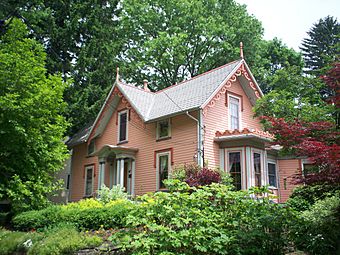Charles Kent House facts for kids
Quick facts for kids |
|
|
Charles Kent House
|
|

Charles Kent House in 2009
|
|
| Location | 125 North Pearl Street Kent, Ohio |
|---|---|
| Built | 1843 |
| Architect | James Clark |
| Architectural style | Gothic Revival Greek Revival Carpenter Gothic |
| NRHP reference No. | 78002174 |
| Added to NRHP | February 23, 1978 |
The Charles Kent House is a historic building in Kent, Ohio. It is also known as the Palmer House. This special house has been listed on the National Register of Historic Places since February 23, 1978. This means it is recognized as an important place in American history.
The house is located at 125 North Pearl Street in central Kent. It stands just north of the West Main Street District.
History of the Charles Kent House
The Charles Kent House was built in 1843. It was originally the home of Charles Kent. Charles was the son of Zenas Kent and the brother of Marvin Kent. Marvin Kent is the person for whom the city of Kent is named.
Moving the House
In 1909, the house was moved from its first spot. The owner at the time, Henry Green, moved it about 150 feet (46 meters) north. It went from West Main Street to its current location on North Pearl Street.
Martin L. Davey helped save the house from being torn down. He convinced the owner to move it instead. Martin L. Davey later became the mayor of Kent. He also served as a U.S. Representative and then as the Governor of Ohio.
Later Owners
For many years, Dr. Maurice and Louisa Palmer owned the house. This is why it is also known as the Palmer House. It was called the Palmer House when it was added to the National Register.
The house used to be white with blue shutters. Its colors were changed after the Palmer family sold it in the early 2000s.
Architectural Style
The Charles Kent House shows off a mix of building styles. Its main style is Gothic Revival. This style often includes pointed arches and decorative details.
The house also has parts of the Greek Revival style. This style often uses columns and designs inspired by ancient Greek temples. You can also see elements of Carpenter Gothic. This is a simpler version of Gothic Revival, often made with wood.



